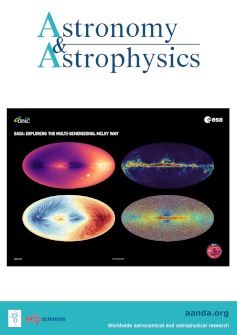Contribution of young massive stellar clusters to the Galactic diffuse γ-ray emission
IF 5.4
2区 物理与天体物理
Q1 ASTRONOMY & ASTROPHYSICS
引用次数: 0
Abstract
Context. Young massive stellar clusters (YMSCs) have emerged as potential γ-ray sources after the recent association of a dozen YMSCs with extended γ-ray emission. The large size of the detected halos, comparable to that of the wind-blown bubble expected around YMSCs, makes the γ-ray detection of individual YMSCs rather challenging. As a result, the emission from most of the Galactic YMSCs could be unresolved, thus contributing to the diffuse γ-ray radiation observed along the Galactic Plane.Aims. In this study, we estimate the possible contribution to the Galactic diffuse γ-ray emission from a synthetic population of YMSCs, and we compare it with observations obtained with different experiments, from 1 GeV to hundreds of teraelectronvolt, in three regions of the Galactic Plane.Methods. As the population of galactic YMSCs is only known locally, we evaluated the contribution of γ-ray emission relying on the simulation of synthetic populations of YMSCs based on the observed properties of local clusters. We computed the γ-ray emission from each cluster assuming that the radiation is purely hadronic in nature and produced by cosmic rays that are accelerated at the cluster’s collective wind termination shock.Results. We find that the γ-ray emission from unresolved YMSCs can significantly contribute to the observed Galactic diffuse flux, especially in the inner part of the Galaxy, and that an important role is played by kinetic power injected by the Wolf-Rayet stellar winds. The predicted γ-ray flux should be considered as a lower limit, given that our calculation does not include the contribution of supernovae exploding in YMSCs.求助全文
约1分钟内获得全文
求助全文
来源期刊

Astronomy & Astrophysics
地学天文-天文与天体物理
CiteScore
10.20
自引率
27.70%
发文量
2105
审稿时长
1-2 weeks
期刊介绍:
Astronomy & Astrophysics is an international Journal that publishes papers on all aspects of astronomy and astrophysics (theoretical, observational, and instrumental) independently of the techniques used to obtain the results.
 求助内容:
求助内容: 应助结果提醒方式:
应助结果提醒方式:


